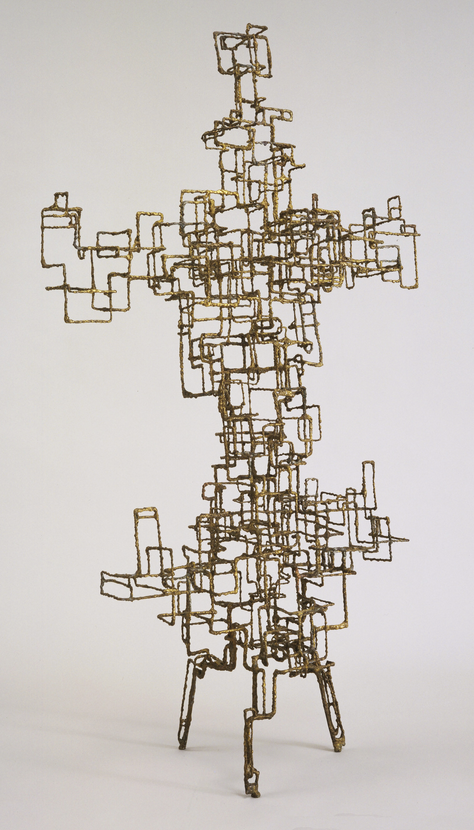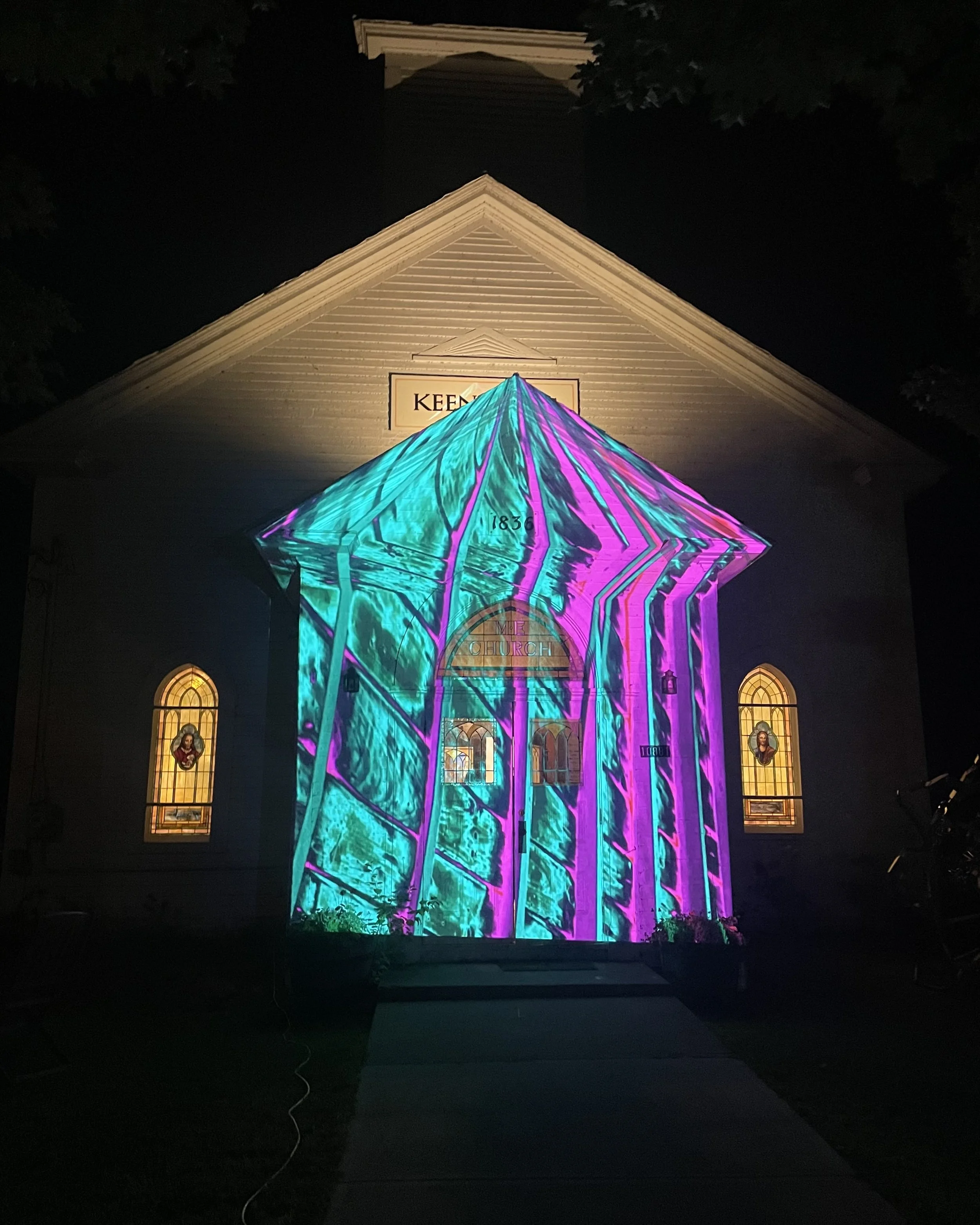LASSAW: THE PROJECTION PAINTINGS PERFORMANCE
Ibram Lassaw with glass slide, c. 1948 © Estate of Ibram Lassaw
Ibram Lassaw, “Kwannon,” 1952, welded bronze, 72 ½ x 43 × 29 in (184.2 × 109.2 × 73.7 cm) Collection of the Museum of Modern Art, New York (196.1952)
LASSAW: THE PROJECTION PAINTINGS PERFORMANCE
a collaborative performance of the late 1940s glass slide projects of Ibram Lassaw performed by Douglas Dunn + Dancers and Gleich Dances with DJ jojoSOUL spinning John Cage.
Projection artist Echo Only will oversee the historic projections.
Special thanks to Denise Lassaw
Thursday, December 11 at 7pm
DOUGLAS DUNN STUDIO
541 Broadway, NYC
General Seating: $25
Norte Maar in collaboration with the Estate of Ibram Lassaw and the Berry Campbell Gallery present Lassaw: The Projection Paintings Performance, a collaborative event featuring the rare 1940s glass slide projects of Ibram Lassaw danced by Douglas Dunn & Dancers and Gleich Dances. Nearly 70 years after they were first presented, Lassaw’s rare glass slide projection paintings will be brought to life through dance and set to the remixing of vinyl recordings of John Cage by DJ jojoSOUL at the Douglas Dunn Studio on Thursday, December 11 at 7pm. The performance, produced by Jason Andrew, is held in conjunction with the exhibition Ibram Lassaw: From Equinox to Solstice at the Berry Campbell Gallery November 20-December 20.
About Ibram Lassaw / Lassaw Projection Paintings:
Ibram Lassaw (1913-2003) is celebrated for his open-form sculpture created by brazing and welding metal into airy, linear compositions. Describing his work as “action sculpture,” Lassaw’s process emphasized spontaneity and gesture, embracing what would soon be known as Abstract Expressionism into three-dimensional form. He was a founding member of both The Club and the American Abstract Artists group. His seminal 1952 sculpture, Kwannon, is on permanent view at the Museum of Modern Art, New York.
In the mid 1940s, before abstract expressionism was a word, the New York art world lived in illegal lofts, and friendships were more like family, the sculptor Ibram Lassaw experimented with colored dyes on plexiglass sculpture. Transferring the process to the flat 2 x 2 inch surface of glass slides he began to animate them layering dye with the aim of projecting them onto the studio wall.
“These tiny paintings could fill a space ten-foot square,” recalls Lassaw’s daughter Denise who is actively involved in this recreation, “and we did what came most naturally, we danced in the colors.”
“Artists friends included Bill and Elaine de Kooning, Paul Jenkins, Milton Resnick, Al Leslie, Philip Pavia, Rudy Burckhardt, Robert Frank, Larry Rivers, Marcel and Tenny Duchamp, John Cage, Merce Cunningham—a list of neighbors too long to include. The colors were so strong that one time a policeman came rushing upstairs thinking the building was on fire!”
The Projection Paintings were used by Friedlander Productions for Fashion Showplace of the Nation presented on May 17, 1948, in a theatre built in Mr. Friedlander's showroom as a new and dramatic way of showing his fall collection designed by Moyen. By the late 1950s the slides sat in a box, rarely shown, until an art historian, Arthur Jones rediscovered them and they were included in a 1992 Lassaw retrospective at the University of Kentucky where Jones taught. In the early 2000s the fragile slides were scanned to preserve and document them.
Now for the first time in nearly 70 years they will be shown again in New York City. There will also be a short slide show of images of life in the loft.
Douglas Dunn + Dancers performing "Nothing Further." Photo: Julieta Cervantes for The New York Times
About Douglas Dunn & Dancers.
Douglas Dunn is an American dancer and choreographer. He is considered a highly eclectic and minimalist postmodern choreographer, who uses humor, props, and text in his dances.
Douglas Dunn started dancing in college in 1962. He began working with Yvonne Rainer in 1968 and was a dancer with her company until 1970. He was a member of the Merce Cunningham Dance Company from 1969-1973. In 1970 he became a member of the avant-garde improvisational group Grand Union until 1976.
Dunn premiered his professional company, Douglas Dunn and Dancers, in 1976. He was commissioned by various companies to choreograph works including the Paris Opera Ballet, Groupe de Recherche Choreographique de l’Opera de Paris, Grande Ballet de Bordeaux, New Dance Ensemble of Minneapolis, Walker Art Center (Minneapolis), Repertory Dance Theater (Salt Lake City), Ballet Theatre Francais de Nancy, Institute for Contemporary Art (Boston), Perth Institute of Contemporary Art (Australia), and Portland State University (Oregon).
He is the recipient of many awards, including a Bessie and Chevalier in the Ordre des Arts et des Lettres, continues to lead Douglas Dunn + Dancers, to teach Open Structures at New York University Steinhardt, and to present Salons at his studio at 541 Broadway in Manhattan. Dancer Out of Sight, his book of collected writings, is available at Amazon.com.
Gleich Dances performing “Immovable.” Photo: Jason Andrew
About Julia K. Gleich / Gleich Dances.
Julia K. Gleich / Gleich Dances is a choreographer known for her innovative and interdisciplinary approach to dance. Her work often explores the intersection of dance with other art forms, including visual arts, music, and technology. Gleich is recognized for her emphasis on the geometric and mathematical underpinnings of choreography, bringing a unique analytical perspective to her artistic creations. And yet Gleich’s process takes on what cultural anthropologist Victor Turner calls the liminoid state “a messy, non-binary state” which is “this or that or that” and not merely “this or not this.” Institutions prefer the liminal, new art lives in the liminoid. And this has been the tension in Gleich’s creative life - how to embrace the dance world without (its his-stories) succumbing to a governing institutional identity. She connects with her field through producing programs of dance, researching her own vector movement theory, and writing about philosophical concerns around contemporary ballet and pedagogy.
As the founder and Artistic Director of Gleich Dances she has been making dances for 25 years and is motivated by working in collaboration, by reflecting a wider community in her work, and by illuminating the relationships between the traditional and the contemporary, scrapping aesthetic labels. Artist collaborations have included Rachel Beach, Sharon Butler, Nicole Cherubini, Tamara Gonzales, Elana Herzog, Meg Lipke, Ellie Murphy, Karen Schifano, Mary Schwab among others.
Gleich was Head of Choreography (2005-2017) at London Studio Centre and on faculty of Trinity Laban Conservatoire of Music and Dance (2003-2017). After 15 years living and teaching in London, she returned to New York City and premiered the full evening ballet “Martha (The Searchers)” in collaboration with Guggenheim Fellow Elana Herzog. Gleich current teaches at Peridance in New York City.
© jojoSOUL
About jojoSOUL.
jojoSOUL is a seasoned music and art practitioner with over 30 years of experience, specializing in drums and percussion. As a composer and live performer, jojoSOUL creates dynamic performances that blend diverse elements, from collaborations with dancers, DJs, and ensembles to cabaret acts and hybrid sound experiences combining vinyl DJing, live drumming, and electronics.
In addition to his performance work, jojoSOUL is an educator and drum accompanist, teaching youth classes and working with schools, guest residencies, and community events. Since 2017, he has been the coordinator of “Back to the Beat”, an uplifting music program aimed at providing drumming education for incarcerated youth at NYS juvenile residence facilities. He also serves as a DJ for the Office of Youth Mental Health.
A passionate student of global music traditions, jojoSOUL has traveled to Guinea and Mali in West Africa, studying with world-renowned djembe masters, griots, and dance companies.
© Echo Only
About Echo Only.
Echo is the co-founder of The Station, an experimental arts space and cultural incubator in Onchiota, NY. He believes it is every human’s responsibility to consistently seek new experiences and relationships that will allow them to question their current beliefs. Echo uses various mediums and live performance elements related to sound, video and projection art to create interactive experiences and social situations. The art forms he uses are constantly evolving and by themselves don’t really interest Echo all that much. What actually interest Echo, is the way art can be used as a tool to generate emotions that cause people to question current social systems. Echo believes every hierarchical social system should be examined and challenged. The curious shall be rewarded.






